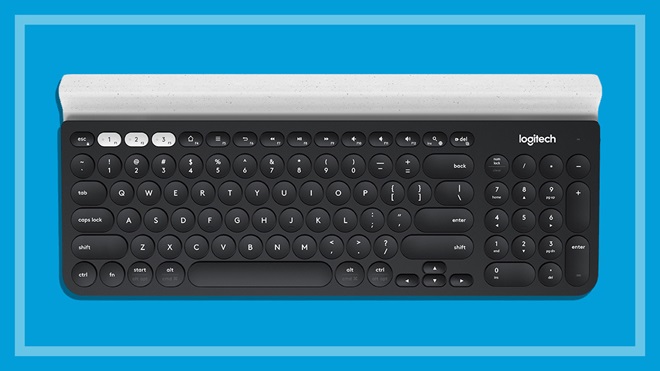CHOICE verdict
The Logitech K780 multi-device keyboard is quiet, responsive and pleasant to type on. Pairing devices and switching between them is simple and the gadget stand makes it even easier. If you're eyeing off those circular keys warily, don't. After a few hours of use, we didn't even notice them. At 875g, it's not the most portable keyboard out there, but it's mostly designed for desktop use, anyway.
Price: $119.95
Contact: logitech.com/en-au
Tired of re-pairing Bluetooth devices to your wireless keyboard? The Logitech K780 can switch between three devices almost instantly, saving time and desk space.

Multi-device keyboards help keep your workspace clean and clutter free.
Pairing and connection
The Logitech K780 multi-device keyboard works with:
- Windows
- Mac
- Chrome OS
- Android
- iPhone and iPad
Multi-device keyboards can be paired to computers, phones and tablets, so you can switch between them without cluttering your space with multiple peripherals.
We found connecting the K780 to each device the first time is a quick process. The instructions are on the inside of the box, and only take a few seconds to follow if your device is ready for pairing.

Switch between devices quickly by pressing the three numbered buttons in the top-left of the keyboard.
It can be paired with up to three devices at once, either via Bluetooth or the single radio frequency USB dongle included in the box.
The range is about 10m and its two (included) AAA batteries should run for 24 months before needing to be replaced, says Logitech.
Once paired, switch between devices by pressing the three numbered buttons in the top-left of the keyboard. The time it takes to change input is usually about how long it takes for your finger to travel back to the letter keys after pressing one of the device buttons, so you barely have to break your typing flow, if at all.
Using with PCs, laptops and Macs
The default layout is for Windows, with some added buttons, but it can be paired with Macs and Chrome OS. It's not quite as wide as many standard keyboards, which can reduce neck strain by letting you use your mouse closer to the centre of your body.
The lack of trackpad is worth noting for those who use their laptop without a mouse. For that, you either need a different mouse per device, or a multi-device mouse such as the Logitech M720 Triathlon ($99.94) or MX Anywhere 2S ($129.95).
Using with phones and tablets
The K780 is useful for typing on phones and tablets, but their inclusion feels more like a bonus than a focus. And how well it works is limited by your operating system and individual app design. There are some handy phone and tablet buttons such as Home, App-Switch, Contextual Menu, Search, Screenshot, and Back, which worked well in all scenarios we tried.
The built-in gadget stand is handy, but also means the keyboard needs enough weight (875g) to hold up a hefty tablet like a Surface or iPad Pro, reducing its portability.
You can unlock a mobile device by hitting the spacebar then typing in your PIN, but you can't open lock screen notifications directly – you have to unlock the phone then find the app.
Navigating phone/tablet and app user interfaces (UIs) is a bit clunky, so you'll still need the touchscreen. This can slow things down a bit, but given your screen is right in front of you (thanks to the stand), it's not much of a hassle.
Being able to type quickly from a keyboard not only makes replying to messages easier, it reduces the potential for the distractions that come from picking up a mobile device. It can also turn your phone or tablet into a portable work or study device, thanks to apps such as the Microsoft Office Suite, Apple Pages, and other productivity options.

Type a message on your phone then finish writing a report with the handy built-in gadget stand.
Using multiple devices at once
Not only does having a single keyboard reduce workspace clutter, switching between devices easily has quickly become something we'll have trouble going back from.
At the moment, many people are working from home with a laptop provided by their employer. If you have your own device as well, it's helpful to switch between work and personal uses to respond to notifications or address personal errands you suddenly remembered.
If your personal computer is more powerful than your work one, you can spend most of your work hours on your most powerful device and only switch back to the work laptop when you need to access secure servers (if your workplace allows official work to be done on personal devices).
An unexpected benefit is portable dual-screening, albeit with restrictions. If you need two screens to work or study, but have always envied people who work from cafes or parks, a multi-device keyboard might solve your problem. It lets you open up spreadsheets or do research on one device and write up reports on the other.
You can't directly copy, paste or drag content between screens because they're not actually connected, but thanks to modern cloud apps such as Google Docs, you can paste content into an open document and have it immediately available on all connected devices.
We're on your side
For more than 60 years, we've been making a difference for Australian consumers. In that time, we've never taken ads or sponsorship.
Instead we're funded by members who value expert reviews and independent product testing.
With no self-interest behind our advice, you don't just buy smarter, you get the answers that you need.
You know without hesitation what's safe for you and your family.
And you'll never be alone when something goes wrong or a business treats you unfairly.
Learn more about CHOICE membership today
Stock images: Getty, unless otherwise stated.



